-

 44cm x 34cm Dublin The Marrowbone Lane Distillery was an Irish whiskey distillery located on Marrowbone Lane, in Dublin, Ireland. One of the "big four" historical Dublin whiskey firms, it was run by William Jameson, a member of the Jameson whiskey dynasty. However, the whiskey now known as Jameson Irish Whiskey was not produced at this distillery, but at the separate enterprise run by John Jameson at the nearby Bow Street Distillery. The distillery closed in 1923 following financial difficulties.The precise origins of the distillery are uncertain, however, it was likely established in the 1750s (possibly 1752) and later acquired by the Stein family, relatives of the Jameson family circa 1780. An excise return in 1802 lists Stein and Jameson, however, by 1822 the company had become William Jameson & Co. Initially a small undertaking, with an output of just 30,000 gallons per annum, the distillery expanded over time, and by the time Alfred Barnard, a British historian visited the distillery in the 1880s, it had grown to cover some 14 acres. In his book, The Whisky Distilleries of the United Kingdom, Barnard described Marrowbone Lane as having some of the biggest distilling equipment in the world, including two mash tuns with capacities in excess of 100,000 gallons, which were the "said to be the largest in the United Kingdom". At its peak, the distillery was the second largest in Dublin (then one of the world's largest whiskey distilling centres), with an output of 900,000 gallons per annum, and a staff of 200, including 30 coopers. The whiskey produced at the distillery, known as "Dublin Whiskey" was chiefly exported to Australia, Canada, India and the United States. Later renamed the Dublin Distilling Company, the company entered financial difficulties in the late 1800s, and in 1891, merged with George Roe's Thomas Street Distillery and the Dublin Whiskey Distillery Company's Jones Road Distillery to form the Dublin Distilleries Company Ltd. Although, the amalgamated company had a potential production capacity of 3.5 million gallons per annum, it continued to endure severe financial difficulties, in particular, following the loss of both the American and British Commonwealth export markets during prohibition and the Anglo-Irish trade war in the 1920s. Both the Thomas Street and Marrowbone Lane distilleries closed in 1923, with the Jones Road Distillery following suit in 1926. Though distilling may have continued at Jones Road until 1946. During the 1916 Easter uprising, both the Marrowbone Lane distillery and Roe's distillery at Thomas Street were used as strongpoints by a force of more than a hundred rebels.
44cm x 34cm Dublin The Marrowbone Lane Distillery was an Irish whiskey distillery located on Marrowbone Lane, in Dublin, Ireland. One of the "big four" historical Dublin whiskey firms, it was run by William Jameson, a member of the Jameson whiskey dynasty. However, the whiskey now known as Jameson Irish Whiskey was not produced at this distillery, but at the separate enterprise run by John Jameson at the nearby Bow Street Distillery. The distillery closed in 1923 following financial difficulties.The precise origins of the distillery are uncertain, however, it was likely established in the 1750s (possibly 1752) and later acquired by the Stein family, relatives of the Jameson family circa 1780. An excise return in 1802 lists Stein and Jameson, however, by 1822 the company had become William Jameson & Co. Initially a small undertaking, with an output of just 30,000 gallons per annum, the distillery expanded over time, and by the time Alfred Barnard, a British historian visited the distillery in the 1880s, it had grown to cover some 14 acres. In his book, The Whisky Distilleries of the United Kingdom, Barnard described Marrowbone Lane as having some of the biggest distilling equipment in the world, including two mash tuns with capacities in excess of 100,000 gallons, which were the "said to be the largest in the United Kingdom". At its peak, the distillery was the second largest in Dublin (then one of the world's largest whiskey distilling centres), with an output of 900,000 gallons per annum, and a staff of 200, including 30 coopers. The whiskey produced at the distillery, known as "Dublin Whiskey" was chiefly exported to Australia, Canada, India and the United States. Later renamed the Dublin Distilling Company, the company entered financial difficulties in the late 1800s, and in 1891, merged with George Roe's Thomas Street Distillery and the Dublin Whiskey Distillery Company's Jones Road Distillery to form the Dublin Distilleries Company Ltd. Although, the amalgamated company had a potential production capacity of 3.5 million gallons per annum, it continued to endure severe financial difficulties, in particular, following the loss of both the American and British Commonwealth export markets during prohibition and the Anglo-Irish trade war in the 1920s. Both the Thomas Street and Marrowbone Lane distilleries closed in 1923, with the Jones Road Distillery following suit in 1926. Though distilling may have continued at Jones Road until 1946. During the 1916 Easter uprising, both the Marrowbone Lane distillery and Roe's distillery at Thomas Street were used as strongpoints by a force of more than a hundred rebels. -

 40cm x 33cm Co Cork
40cm x 33cm Co CorkEvery country has its own slang terms or local colloquialisms and Ireland is no different. Many of the country's famous sayings are well-known worldwide, but there may be one or two you're not familiar with. No doubt you'll be wanting to experience the 'craic' for yourself as you explore your new surroundings, so we've put together this 'bang-on' guide to the local lingo!
Craic is probably the most popular and familiar slang phrase, simply meaning ‘fun’ or ‘banter’, just good times. It has origins with the Ulster Scots, who told of the crack, the Gaelic spelling not fully popularised in Ireland until the 1970s, when it was the catchphrase of the Irish-language TV show SBB ina Shuí.
Some other slang phrases might not be quite as familiar, and each region of Ireland has its own particular lingo, but here are some of the weird and wonderful words and phrases that might come in handy, and save you from making an eejit or a gowl of yourself!Gowl: An annoying person. Ah, ye GOW-EL ye!
Wisht: Shush! A handy one for in the cinema, or for chatterboxes in lectures.
Scarlet: Embarrassed. Hopefully not because you’ve been a gowl. I was such an eejit, I was scarlet!
Wired to the moon: Maybe you’ve been out late, enjoying the craic a little too much, and you’ve grabbed a triple espresso on the way to the lecture theatre? You’re wired to the moon.
Wee: Small, but everything in Ireland is wee. If Dwayne ‘The Rock’ Johnson were to visit Ireland, he’d be Wee Dwayne.
Quare: Meaning ‘great’. It’s quare weather out today! Also used for ‘very’. It’s quare warm today!
Savage: Something excellent. Was it a good craic last night? Oh, it was savage!
The Jacks: The toilets, fir jacks for the mens, ban jacks for the ladies, not to be confused with…
Banjaxed: Broken. Ruined.
Happy out: Simply happy. You’re enjoying the craic, having a quare old time, you’re happy out.
Sure look at it: A suitable reply to nearly any statement. Isn’t this weather grand? Ah, sure look at it!
Ossified: Very drunk. Regretfully so. See also: langers, blathered, locked.
The messages: If you hear people referring to doing the messages, they're going shopping. Does anyone need anything? I’m heading out to do the messages.
The press: An Irish term for the cupboard. You might want to check you’ve enough biscuits in the press, before you set off to do the messages.
Are you okay?: If the barman is asking you this, he’s not checking on your state of being, simply wanting to know what you want to order.
I’ve a throat on me: Thirsty. Just don’t get too ossified and make an eejit of yourself!
Me ould segotia, me ould sweat, me ould flower: Best friend.
Aculsha: An old term of affection, from a chuisle mo chroí, ‘pulse of my heart’
A soft day: A drizzly rainy, misty day.
Acting the maggot: Being silly, making a nuisance. An annoying person.
Making a bags of it: Making a mess of something.
Cat altogether: Something bad. If the weather is terrible, it could be cat altogether out there.
Even if you’re apprehensive about using some of these phrases in your conversations, it’ll certainly help you understand what your new Irish friends are saying. Ah, it was quare warm yesterday, I’d meant to do the messages, but I’d quite the throat on me. I got utterly langers, made a right gowl of meself acting the maggot, and I’m totally banjaxed today. Savage! -

 47cm x 38cm The Great Northern Railway (Ireland) (GNR(I) or GNRI) was an Irish gauge (1,600 mm (5 ft 3 in)) railway company in Ireland. It was formed in 1876 by a merger of the Irish North Western Railway (INW), Northern Railway of Ireland, and Ulster Railway. The governments of Ireland and Northern Ireland jointly nationalised the company in 1953, and the company was liquidated in 1958: assets were split on national lines between the Ulster Transport Authority and Córas Iompair Éireann.
47cm x 38cm The Great Northern Railway (Ireland) (GNR(I) or GNRI) was an Irish gauge (1,600 mm (5 ft 3 in)) railway company in Ireland. It was formed in 1876 by a merger of the Irish North Western Railway (INW), Northern Railway of Ireland, and Ulster Railway. The governments of Ireland and Northern Ireland jointly nationalised the company in 1953, and the company was liquidated in 1958: assets were split on national lines between the Ulster Transport Authority and Córas Iompair Éireann.Foundation
The Ulster, D&D and D&BJct railways together formed the main line between Dublin and Belfast, with the D&BJct completing the final section in 1852 to join the Ulster at Portadown. The GNRI's other main lines were between Derry and Dundalk and between Omagh and Portadown. The Portadown, Dungannon and Omagh Junction Railway together with the Londonderry and Enniskillen Railway enabled GNRI trains between Derry and Belfast to compete with the Belfast and Northern Counties Railway, and both this and the Dundalk route gave connections between Derry and Dublin. These main lines supported the development of an extensive branch network serving the southwest half of Ulster and northern counties of Leinster. The GNRI became Ireland's most prosperous railway company and second largest railway network. In its early years the GNR(I) closely imitated the image of its English namesake, adopting an apple green livery for its steam locomotives and a varnished teak finish for its passenger coaches. Later the company adopted its famous pale blue livery for locomotives (from 1932), with the frames and running gear picked out in scarlet. Passenger vehicles were painted brown, instead of varnished. On 12 June 1889, a significant rail accident occurred when a passenger train stalled between Armagh and Newry. The train was divided, but during the uncoupling operation ten carriages ran away and collided with another passenger train. A total of 80 people were killed and 260 were injured in what was then the deadliest railway accident to have occurred in Europe. The accident remains the deadliest ever to have occurred on the island of Ireland.Growth and partition
In the early 20th century increasing traffic led the GNRI to consider introducing larger locomotives. The Great Southern & Western Railway had introduced express passenger locomotives with a 4-6-0 wheel arrangement, and the GNRI wanted to do the same. However, the lifting shop in the GNRI Dundalk works was too short to build or overhaul a 4-6-0, so the company persisted with 4-4-0 locomotives for even the heaviest and fastest passenger trains. This led to the GNRI to order a very modern and powerful class of 4-4-0's, the Class V three cylinder compound locomotives built by Beyer, Peacock & Company in 1932. This class has been compared with another notable V class, that introduced by the Southern Railway in England in 1930. The Partition of Ireland in 1921 created a border through the GNRI's territory. The new border crossed all three of its main lines and some of its secondary lines. The imposition of border controls caused some service disruption, with main line trains having to stop at both Dundalk and Goraghwood stations. This was not eased until 1947 when customs and immigration facilities for Dublin–Belfast expresses were opened at Dublin Amiens Street and Belfast Great Victoria Street stations.Nationalisation and division
A combination of the increasing road competition facing all railways and a change in patterns of economic activity caused by the Partition of Ireland reduced the GNRI's prosperity. The company modernised and reduced its costs by introducing modern diesel multiple units on an increasing number of services in the 1940s and 1950s and by making Dublin–Belfast expresses non-stop from 1948. In Dundalk at the GNR Works the railway engineers developed railbuses for use on sections of the rural network. Nevertheless, by the 1950s the GNRI had ceased to be profitable and in 1953 the company was jointly nationalised by the governments of the Republic of Ireland and Northern Ireland. The two governments ran the railway jointly under a Great Northern Railway Board until 1958.In May 1958, the Government of Northern Ireland's wish to close many lines led to the GNR(I) Board being dissolved and the assets divided between the two territories. At midnight on 30 September 1958, all lines entirely within Northern Ireland were transferred to the (nationalised) Ulster Transport Authority (UTA) and all lines entirely within the Republic of Ireland were transferred to Córas Iompair Éireann (CIÉ). CIÉ had been formed as a private company in 1945 but had been nationalised in 1950. In an attempt at fairness, all classes of locomotive and rolling stock were also divided equally between the transport operators of the two new owners.: 184–185 Most classes of GNRI locomotive had been built in small classes, so this division left both railways with an operational and maintenance difficulty of many different designs all in small numbers. The Government of Northern Ireland, which had a very anti-rail policy, rapidly closed most of the GNR(I) lines in Northern Ireland.Exceptions were the Belfast–Dundalk and Portadown–Derry main lines and the Newry–Warrenpoint and Lisburn–Antrim branches. It made the Lisburn–Antrim branch freight-only from 1960 and closed the Portadown–Derry and Newry–Warrenpoint lines to all traffic in 1965.The Republic of Ireland government tried briefly to maintain services on lines closed at the border by the Northern Ireland government, but this was impractical, and the Republic had to follow suit in closing most GNR(I) lines within the Republic. Since 1963, the Drogheda–Navan branch has survived for freight traffic only. The GNR's north western main line between Dundalk and Derry bypassed the small County Tyrone town of Fintona, which was instead served by a 1 mile (1.6 km) branch line from Fintona Junction station. The service was operated by the double-deck Fintona horse tram until the line's closure in 1957. CIÉ also acquired the Hill of Howth Tramway, in the northern suburbs of Dublin, in the 1958 dissolution of the GNRI Board. CIÉ closed the tramway about a year later. Today, the GNR routes remaining consist of the main line from Dublin to Belfast, the Howth branch, electrified for Dublin commuter services since 1984, the Drogheda - Navan (Tara Mines) line, which carries only freight traffic associated with that mine, passenger traffic having ceased with the closure of the line beyond there to Oldcastle in 1963, and the Lisburn to Antrim branch, now mothballed but retained in operational order for the time being. Preserved GNRI Class S no. 171 Slieve Gullion at Lisburn
Preserved GNRI Class S no. 171 Slieve Gullion at LisburnPreservation
Rolling stock
 No.85 taking on water on the former Northern Counties Committee line at Ballymena railway station.
No.85 taking on water on the former Northern Counties Committee line at Ballymena railway station. -
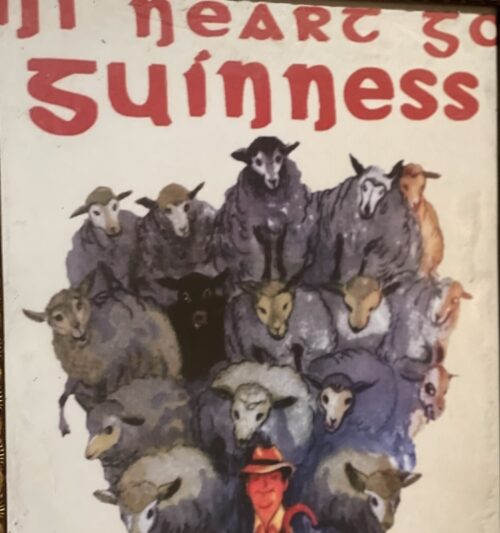
 35cm x 47cm Imagination is something Guinness Advertising has never been short of… From John Gilroy’s hapless zookeeper and his menagerie of creatures to a Polynesian surfer and a herd of white horses; from messages in bottles setting sail across the ocean to a single, heart-stoppingly enormous wave. Guinness have been carving out their own creative path for almost a century with decades of extraordinary and enduring print, TV and digital campaigns to their name, and hopefully they will continue to push boundaries to tell stories to the world. Here’s to original thinking !
35cm x 47cm Imagination is something Guinness Advertising has never been short of… From John Gilroy’s hapless zookeeper and his menagerie of creatures to a Polynesian surfer and a herd of white horses; from messages in bottles setting sail across the ocean to a single, heart-stoppingly enormous wave. Guinness have been carving out their own creative path for almost a century with decades of extraordinary and enduring print, TV and digital campaigns to their name, and hopefully they will continue to push boundaries to tell stories to the world. Here’s to original thinking ! -

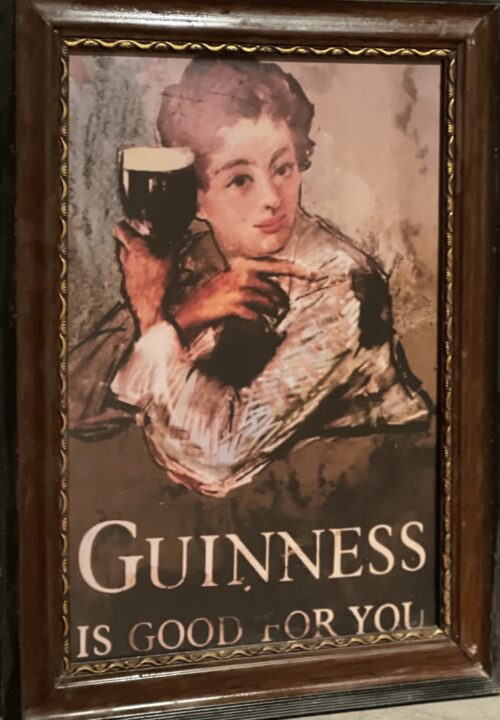 35cm x 45cm Imagination is something Guinness Advertising has never been short of… From John Gilroy’s hapless zookeeper and his menagerie of creatures to a Polynesian surfer and a herd of white horses; from messages in bottles setting sail across the ocean to a single, heart-stoppingly enormous wave. Guinness have been carving out their own creative path for almost a century with decades of extraordinary and enduring print, TV and digital campaigns to their name, and hopefully they will continue to push boundaries to tell stories to the world. Here’s to original thinking !
35cm x 45cm Imagination is something Guinness Advertising has never been short of… From John Gilroy’s hapless zookeeper and his menagerie of creatures to a Polynesian surfer and a herd of white horses; from messages in bottles setting sail across the ocean to a single, heart-stoppingly enormous wave. Guinness have been carving out their own creative path for almost a century with decades of extraordinary and enduring print, TV and digital campaigns to their name, and hopefully they will continue to push boundaries to tell stories to the world. Here’s to original thinking ! -
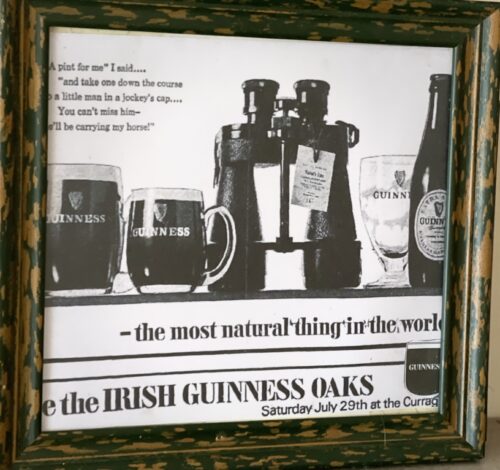
 38cm x 40cm Imagination is something Guinness Advertising has never been short of… From John Gilroy’s hapless zookeeper and his menagerie of creatures to a Polynesian surfer and a herd of white horses; from messages in bottles setting sail across the ocean to a single, heart-stoppingly enormous wave. Guinness have been carving out their own creative path for almost a century with decades of extraordinary and enduring print, TV and digital campaigns to their name, and hopefully they will continue to push boundaries to tell stories to the world. Here’s to original thinking !
38cm x 40cm Imagination is something Guinness Advertising has never been short of… From John Gilroy’s hapless zookeeper and his menagerie of creatures to a Polynesian surfer and a herd of white horses; from messages in bottles setting sail across the ocean to a single, heart-stoppingly enormous wave. Guinness have been carving out their own creative path for almost a century with decades of extraordinary and enduring print, TV and digital campaigns to their name, and hopefully they will continue to push boundaries to tell stories to the world. Here’s to original thinking ! -

 45cm x 38cm The Sunday Press was a weekly newspaper published in Ireland from 1949 until 1995. It was launched by Éamon de Valera's Irish Press group following the defeat of his Fianna Fáil party in the 1948 Irish general election. Like its sister newspaper, the daily The Irish Press, politically the paper loyally supported Fianna Fáil. The future Taoiseach Seán Lemass was the managing editor of the Irish Press who spearheaded the launch of the Sunday paper, with the first editor Colonel Matt Feehan. Many of the Irish Press journalists contributed to the paper. 'When I open the pages, I duck' was Brendan Behan's description of reading The Sunday Press, for the habit of published memoirs of veterans (usually those aligned to Fianna Fáil) of the Irish War of Independence. It soon built up a large readership, and overtook its main competitor the Sunday Independent, which tended to support Fine Gael. At its peak The Sunday Press sold up to 475,000 copies every week, and had a readership of over one million, around one third of the Irish population. Like the Evening Press, the paper's readership held up better over the years than that of the flagship title in the group, The Irish Press, and it might have survived as a stand-alone title had it been sold. However, with the collapse of the Irish Press Newspapers group in May 1995, all three titles ceased publication immediately. The launch of Ireland on Sunday in 1997 was initially interpreted by many observers as an attempt to appeal to the former readership of The Sunday Press, seen as generally rural, fairly conservative Catholic, and with a traditional Irish nationalist political outlook. When Christmas Day fell on Sunday in 1949, 1955, 1960, 1966, 1977, 1983, 1988 and 1994 the paper came out on the Saturday. Vincent Jennings at the age of 31 became editor of The Sunday Press in 1968, serving until December 1986, when he became manager of the Irish Press Group. Journalists who worked at the press include Stephen Collins served as political editor his father Willie Collins was deputy editor and Michael Carwood became sports editor of The Sunday Press in 1988 until its closure in 1995.
45cm x 38cm The Sunday Press was a weekly newspaper published in Ireland from 1949 until 1995. It was launched by Éamon de Valera's Irish Press group following the defeat of his Fianna Fáil party in the 1948 Irish general election. Like its sister newspaper, the daily The Irish Press, politically the paper loyally supported Fianna Fáil. The future Taoiseach Seán Lemass was the managing editor of the Irish Press who spearheaded the launch of the Sunday paper, with the first editor Colonel Matt Feehan. Many of the Irish Press journalists contributed to the paper. 'When I open the pages, I duck' was Brendan Behan's description of reading The Sunday Press, for the habit of published memoirs of veterans (usually those aligned to Fianna Fáil) of the Irish War of Independence. It soon built up a large readership, and overtook its main competitor the Sunday Independent, which tended to support Fine Gael. At its peak The Sunday Press sold up to 475,000 copies every week, and had a readership of over one million, around one third of the Irish population. Like the Evening Press, the paper's readership held up better over the years than that of the flagship title in the group, The Irish Press, and it might have survived as a stand-alone title had it been sold. However, with the collapse of the Irish Press Newspapers group in May 1995, all three titles ceased publication immediately. The launch of Ireland on Sunday in 1997 was initially interpreted by many observers as an attempt to appeal to the former readership of The Sunday Press, seen as generally rural, fairly conservative Catholic, and with a traditional Irish nationalist political outlook. When Christmas Day fell on Sunday in 1949, 1955, 1960, 1966, 1977, 1983, 1988 and 1994 the paper came out on the Saturday. Vincent Jennings at the age of 31 became editor of The Sunday Press in 1968, serving until December 1986, when he became manager of the Irish Press Group. Journalists who worked at the press include Stephen Collins served as political editor his father Willie Collins was deputy editor and Michael Carwood became sports editor of The Sunday Press in 1988 until its closure in 1995. -
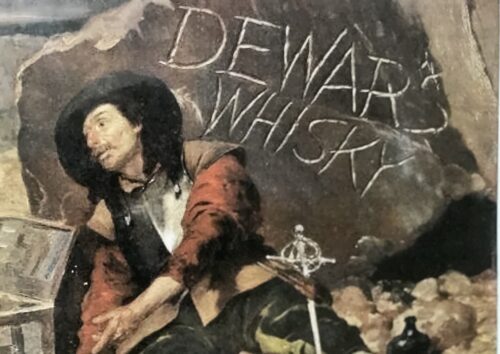
 57cm x 48cm The Dewar's whisky brand was created by John Dewar, Sr. in 1846.Under the control of his two sons, John A. Dewar Jr. and Thomas "Tommy" Dewar, the brand expanded to become a global market leader by 1896 and began to win several awards, including a gold medal in the 1904 St. Louis World's Fair. Tommy became famous as the author of a travel journal, Ramble Round the Globe, which documented his travels while publicizing the Dewar name. Dewar's eventually expanded their product by constructing the Aberfeldy Distillery in 1896.The company joined Distillers Company in 1925. Distillers was acquired by Guinness in 1986, and Guinness merged with Grand Metropolitan to form Diageo in 1997. Diageo sold Dewar's to Bacardi the next year. Dewar's rose to prominence in the United States when Andrew Carnegie requested a small keg of Dewar's Scotch whisky be sent to the White House for President James Garfield's inauguration. Carnegie also sent the same gift to President Benjamin Harrisonon his inauguration eight years later. In 1987, numerous cases of still perfect Dewar's Scotch were recovered by underwater archaeologist E. Lee Spence from the shipwreck of the SS Regina, which sank in Lake Huron in 1913.
57cm x 48cm The Dewar's whisky brand was created by John Dewar, Sr. in 1846.Under the control of his two sons, John A. Dewar Jr. and Thomas "Tommy" Dewar, the brand expanded to become a global market leader by 1896 and began to win several awards, including a gold medal in the 1904 St. Louis World's Fair. Tommy became famous as the author of a travel journal, Ramble Round the Globe, which documented his travels while publicizing the Dewar name. Dewar's eventually expanded their product by constructing the Aberfeldy Distillery in 1896.The company joined Distillers Company in 1925. Distillers was acquired by Guinness in 1986, and Guinness merged with Grand Metropolitan to form Diageo in 1997. Diageo sold Dewar's to Bacardi the next year. Dewar's rose to prominence in the United States when Andrew Carnegie requested a small keg of Dewar's Scotch whisky be sent to the White House for President James Garfield's inauguration. Carnegie also sent the same gift to President Benjamin Harrisonon his inauguration eight years later. In 1987, numerous cases of still perfect Dewar's Scotch were recovered by underwater archaeologist E. Lee Spence from the shipwreck of the SS Regina, which sank in Lake Huron in 1913. John Dewar & Sons 1926 client correspondence with watermark on document
John Dewar & Sons 1926 client correspondence with watermark on documentNotable processes
Dewar's pioneered the process of "marrying" the whisky in oak casks to allow the blend to age as one within the casks. After the blend is created, the whisky is returned to an oak cask and aged even further to obtain a smooth, robust finish.









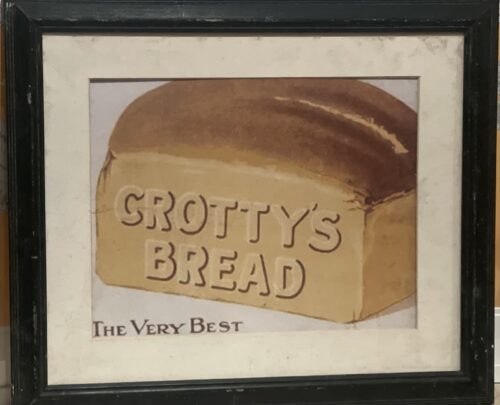
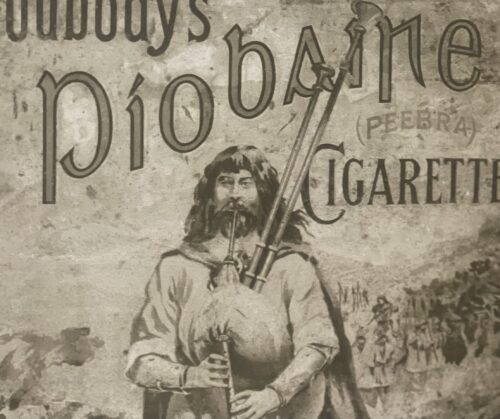

 58cm x 47cm
58cm x 47cm